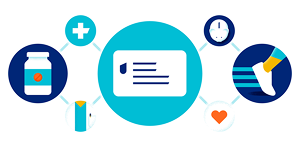GLP-1s are a class of drugs that have been around for the past 20 years. At first, doctors prescribed these drugs to people with type 2 diabetes because these medications were “designed to help the pancreas produce insulin.”1 But in the past few years, doctors have begun prescribing them for weight loss after the Food and Drug Administration approved GLP-1s for people with obesity.2
That’s because taking GLP-1s may help you lose 10% or more of your body weight.2 But what you eat and do also plays a role in your weight-loss journey. So, it’s important to know what foods to include in your diet when you’re taking weight loss medications — and those to avoid.
Read on to learn how GLP-1s work on your appetite and the foods that can boost weight loss and reduce side effects.
How do GLP-1 medications work?
GLP-1 weight-loss drugs help “lower blood sugar levels and promote weight loss” by getting your body to release insulin from your pancreas and blocking the body’s secretion of a natural hormone called glucagon that raises your blood sugar levels. It also makes your stomach empty more slowly after meals and helps you feel fuller for longer.3
So while you’re taking these medications, you tend to eat less food at each meal and still feel satisfied. At the same time, GLP-1s have other health benefits. They lower blood sugar and cholesterol levels. They also improve your blood pressure and lower the risk of heart attacks and strokes.2
Understanding the role of your diet when taking weight-loss medications
GLP-1s curb hunger and reduce appetite. There’s also evidence that GLP-1s help you stop thinking about food all the time, so you’re not as likely to binge or give in to cravings. While that’s a good thing, you may find yourself eating too little or even skipping meals.2,4
That's why making healthy food choices is more important than ever. The foods you choose should fuel your body, keep up your energy and help you retain muscle strength.
Your goal? Focus on nutrient-rich fruits and vegetables that are good for your digestion, lean proteins that keep you full and whole grains that provide steady energy.
Kickstart your weight-loss journey with Noom and get tips and advice. See if you qualify for Noom's weight loss medication option today.
The building blocks: foods to prioritize for weight-loss success
Power up on lean protein. When you’re on GLP-1s it’s important to eat plenty of protein. Protein-rich foods can protect your muscles during weight loss, so most lost weight comes from fat rather than muscle.
Try adding lean proteins to your diet like: 2,4
- Chicken or turkey: Lower in saturated fat but packed with protein to keep muscles strong.
- Seafood like salmon, tuna and sardines: Provide protein plus omega-3 fats for heart and brain health.
- Eggs: High-quality, versatile protein.
- Low-fat dairy: Greek yogurt or cottage cheese offer protein and calcium for strong bones.
- Beans, lentils or tofu: Plant-based proteins with fiber will help you feel full longer and help prevent constipation.
Include a serving of protein at each meal. Eating protein throughout the day helps maintain energy and avoids muscle loss as you lose weight.2,4
Add gut-friendly fiber and whole grains. Protein is important, but it’s not the only nutrient to add to your meals. Vegetables, fruits and whole grains provide fiber that helps you feel full longer. Fiber also helps digestion and avoid constipation. Remember, beans and lentils are also high in fiber.5
Don't forget healthy fats like nuts, seeds, olive oil or avocado. Fats help your body absorb vitamins. They also provide steady energy and make smaller meals more satisfying.6
Focus on hydrating foods too. Water-rich foods help prevent dehydration and reduce side effects like dizziness or constipation. Some examples include cucumbers, melons and soups.7
Including these foods can make it easier to stick with your GLP-1 treatment. They educe nausea or digestive discomfort and support steady, healthy weight loss.2
Foods to limit or avoid on GLP-1s
GLP-1s can cause side effects such as nausea, bloating or diarrhea.8 Some foods can help minimize side effects, while others may make them worse. Limiting these foods can help you feel better and stay on track with your weight loss goals.
GLP-1 foods to avoid: 2,8
- Fried foods: Heavy, greasy meals slow digestion and can increase queasiness.
- Greasy or fatty meats: High saturated fat may worsen bloating or discomfort.
- Sugary desserts and drinks: Can cause blood sugar spikes and crashes, making it harder to manage your appetite.
- Processed snacks: Chips or packaged pastries are high in salt and fat, which can increase bloating.
- Large portions of pizza, burgers or meals with lots of cheese: Can overwhelm the stomach and may make you nauseous or give you heartburn.
- Alcohol: Adds empty calories and sugar. Better to limit it and drink herbal tea, water and non-caffeinated, sugar-free beverages instead.
Meal planning and practical tips for your weight-loss journey
What you eat is just one piece of the puzzle. How you eat can make a difference too. Simple tweaks to your mealtime routines can help reduce side effects. Even better, it can boost steadier weight loss: 2
- Eat smaller, more frequent meals. Smaller portions are easier on your stomach and may help cut down queasy feelings.
- Slow down at mealtimes. GLP-1s can make you feel full faster, so eating slowly may prevent overeating or that uncomfortable “stuffed” feeling.
- Drink up. Sip water or other low-cal beverages like iced tea throughout the day — even if you don’t feel thirsty — to help prevent dehydration.
- Listen to your body. Stop eating when you feel satisfied to reduce discomfort and support healthy weight loss.
Regular exercise can also help protect your muscles while boosting your energy levels and speeding up weight loss.2
Explore a membership program with Noom to see how personal coaching can help you manage your weight.
How can a dietitian or nutritionist help me while I take GLP-1s?
Dietitians and nutritionists are healthcare professionals who specialize in food and nutrition. They can help you set realistic goals that fit your lifestyle to support your weight loss journey.9
Everyone reacts differently to GLP-1s, and it’s normal to have questions or need extra support. Asking for an expert’s help is a smart step — not something to feel embarrassed about. A registered dietitian or nutritionist can:
- Create a meal plan tailored to your needs and preferences
- Make sure you’re getting enough protein and nutrients while eating fewer calories
- Adjust meal timing, portion sizes and drinks to help you feel your best
- Give you strategies to reduce side effects and boost weight loss
Working with a professional can make it easier to stay on track with GLP-1 treatment. Even better, they give you the strategies and support so you can maintain the healthy habits you're developing — now and for the future.
Have questions about a Noom membership? Call 1-844-211-7730 to speak with a licensed insurance agent or explore Noom online.
For informational purposes only. This information is compiled by UnitedHealthcare, and/or one of its affiliates, and does not diagnose problems or recommend specific treatment. Services and medical technologies referenced herein may not be covered under your plan. Please consult directly with your primary care physician if you need medical advice.
Sources
- Society of Behavioral Medicine. “What are GLP-1 medications? 9 common questions.” Accessed September 7, 2025. Retrieved from https://www.sbm.org/healthy-living/what-are-glp-1-medications-9-common-questions
- UCHealth. “Many people using GLP-1 weight loss drugs may not be eating enough nutritious food.” May 19, 2025. Retrieved from https://www.uchealth.org/today/nutrition-vital-when-taking-glp-1-weight-loss-drugs/
- Cleveland Clinic. “GLP-1 Agonists.” September 17, 2025. Retrieved from https://my.clevelandclinic.org/health/treatments/13901-glp-1-agonists
- Mayo Clinic health System. “Are you getting enough protein?” September 17, 2025. Retrieved from https://www.mayoclinichealthsystem.org/hometown-health/speaking-of-health/are-you-getting-too-much-protein
- Harvard Health Publishing. “Foods high in fiber: Boost your health with fiber-rich foods.” September 17, 2025. Retrieved from https://www.health.harvard.edu/nutrition/foods-high-in-fiber-boost-your-health-with-fiber-rich-foods
- MercyOne.org. “Four foods rich in healthy fats you should be eating.” September 17, 2025. Retrieved from https://www.mercyone.org/blog-articles/four-foods-rich-healthy-fats-you-should-be-eating
- Harvard Health Publishing. “Using food to stay hydrated.” September 17, 2025. Retrieved from https://www.health.harvard.edu/staying-healthy/using-food-to-stay-hydrated
- Ohio State University Wexner Medical Center. “Taking a GLP-1? Here are foods to limit — and what to prioritize.” September 17, 2024. Retrieved from https://health.osu.edu/wellness/exercise-and-nutrition/glp1-foods-to-limit
- Cleveland Clinic. “Dietitian.” Reviewed December 19, 2024. Retrieved from https://my.clevelandclinic.org/health/articles/dietitian
Part Number:
52731-X-0925









